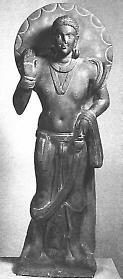 |
THE
ART OF GANDHARA |
 Gandhara
is the name of an ancient region invaded in 326 B.C. by Alexander the
Great. This region comprised almost the whole territories of the modern
Afghanistan and Pakistan. Gandhara
is the name of an ancient region invaded in 326 B.C. by Alexander the
Great. This region comprised almost the whole territories of the modern
Afghanistan and Pakistan.
After the emperor Asoka introduced the Buddhism during the third century
B.C., Ghandara became the second Holy Land of this religion and
many monasteries were founded everywhere in the country. During the
following centuries, a new style of art was developed which played an
important role in the future development of the Indian art.
The genesis of this
style, just called " Gandhara " is still now under debate,
since it is quite different form the preceding and the following ones.
The unsolved problem is its relationships with the Western culture. In
fact the sculptures and the stucco decorations of the holy buildings
seemed to be strongly affected by the Ellenistic or late-Roman aesthetic
rules, specially in the anatomic details of the bodies and in the
garments which were often mistaken for a Roman toga.
Furthermore in the past some scientists tried to recognise in some
sculptures of the Gandhara period representations of classical deities
or scenes belonging to the Greek-Roman mythology. However these attempts
generally failed since all the themes of the Gandhara art are purely
Buddhist and hence Indian.
The characteristic
Gandhara sculpture, of which hundreds if not thousands of examples have
survived such as the great statues in Bamiyan, is the standing or seated
Buddha mostly shown making one of the four significant hand-gestures
known as mudrās.
Other being commonly represented is the Bodhisattva, a future Buddha,
standing or seated, often wearing ornaments and jewellery similarly with
the Hindu practice and style. This perfectly reflects the essential
nature of the Gandhara art, in which a religious and an aesthetic
element drawn from widely different cultures are brought together.
Therefore the art of
Gandhara is at the same time the carrier of the last Ellenistic artistic
culture, which survived in those border territories, and the beginning
of the great Indian art. |